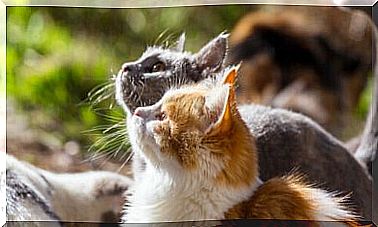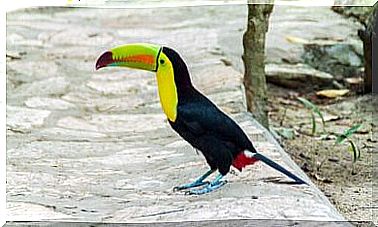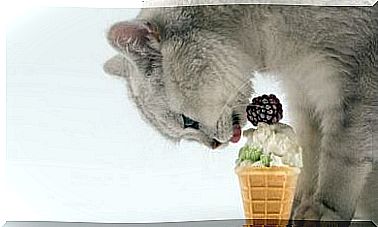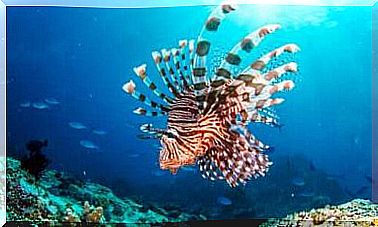Domestic Turtles: 4 Types To Know

In some countries it is not allowed to have these types of reptiles as pets. In Italy and in Europe, many people can still decide to welcome domestic turtles into their home. It is a valid alternative to a dog or a cat, if you have little space available or little time to devote to them. In this article we will show you 4 types of these animals that you can keep at home without problems, showing you their characteristics and how to take care of them.
How many types of domestic turtles are there?
As a first step, we need to distinguish between freshwater turtles and land turtles . The former need to live in contact with water (with the need to set up a small pond or aquarium), while the latter require a large terrarium to sleep, eat and defecate.
In both cases, both the ambient temperature and the sunlight they receive are critical. Do not forget that the Chelonia reptiles are cold-blooded animals and must spend many hours in the sun, to be able to warm up and survive the winter unscathed.
Among the types of domestic turtles, we find:
1. North American forest turtle
Its scientific name is Glyptemys insculpta – visible in the image that opens this article – and it is native to North America. It can be recognized by its dark gray shell, legs, head and orange abdomen with black spots. Its limbs are sturdy and slightly webbed.
Males are larger than females, although in general they measure around 23 centimeters and weigh a kilo when they are adults. They are omnivorous and can feed on plants, fungi and fruits, as well as carrion and invertebrates. The forest turtle is 100% terrestrial in spring and summer, although in winter and autumn it prefers areas with a lot of water.
2. Russian tortoise
Also called Horsfield’s Tortoise , it is the most common of the types of domestic tortoises, very present in homes all over the world. It has a rounded and tall shell, with round and flattened spots, ranging from light yellow to black. The head is sturdy and the extremities have very developed nails. It can measure up to 22cm.

In terms of longevity, this “four-toed turtle” reaches 40 years of life in wild form, although in captivity it can even reach the threshold of 100. Its eyesight is excellent, it can recognize people, it is sensitive to the vibrations of the ground. and he has a powerful sense of smell, which he needs to get food: grass, flowers, vegetables and fruit.
3. Painted Marsh Turtle
It is common in North America and lives in water. It usually inhabits streams and small rivers, marshy, humid areas or near lakes and ponds. In some countries it is considered an invasive species.
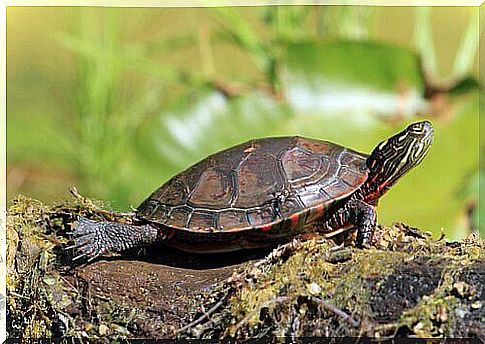
Its shell can measure around 25 centimeters in length and impresses with its yellow and red striped design that appears to be hand painted. The skin is olive green or black with orange and yellow lines. It can live up to 25 years, it needs a relatively large pond with water at a comfortable temperature (24-26 degrees during the day, 19-20 at night).
4. Red eared turtle
We close our review with this type of tortoise which, however, can be found in the wild in the United States and Mexico. Also known as the “Florida tortoise”, this animal is famous for the two red stripes on the sides of its head. They look like real ears and this aesthetic peculiarity makes this Chelonian in great demand.
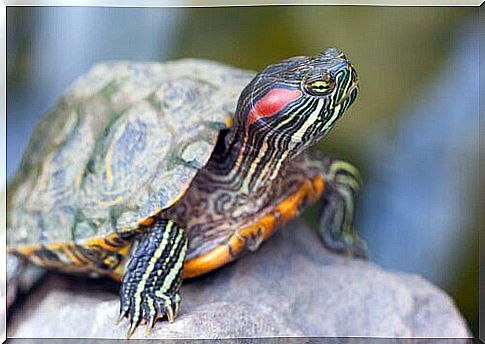
It can reach 30 centimeters in length and females are somewhat larger than males. In any case, they live up to 40 years and, although they spend a lot of time in the water, they also require a humid habitat with direct solar contact, to keep the body temperature constant.
The red-eared turtle is an excellent swimmer, loves being in the sun during the hottest hours and, in case of having to share the territory with other specimens, it can even become aggressive. It hibernates at the bottom of ponds during the winter.
If you decide to get a red eared turtle as a pet, you should keep in mind that it is very vulnerable to infections and can transmit salmonellosis to children. As for her diet, you can give her grass, fish, insects, fruits and vegetables.
